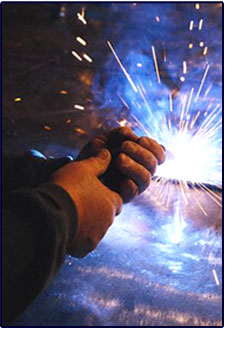| Editor’s Note: “Welding Fumes Health Hazards” by Vicki Bell was published March 11, 2004 by thefabricator.com and served as the source of much of this article. It is an excellent reference for more information on the subject. A study by the National Institute for Occupational Safety and Health (NIOSH) is raising concerns about the risks faced by welders from exposure to fumes. Sources of welding fumes are numerous and include the base material and filler, oil and coatings on the material, electrodes, shielding gases, vapors from cleaners and degreasers, and chemical reactions from the ultraviolet light of the arc and the heat generated. What contaminants pose a health risk? The list is daunting: nickel chromium, asbestos, manganese cadmium, nitrogen oxides, lead, arsenic, selenium and others. Adverse health effects linked to welding smoke include ‘metal fume fever’; irritation of eyes, nose, chest and respiratory tract; bronchitis or fluid in the lungs - all from high, short-term exposures. Long-term, chronic exposure may cause asthma, lung cancer, cancer of the larynx and even nervous system disorders such as a Parkinson’s-like disease. |
|||||||||||||
 |
Researchers acknowledge it's hard to draw conclusions about the hazards of welding fumes due to the variety of materials used in welding and a lack of laboratory-controlled toxicology studies of biochemical reactions to welding fumes. Still, welders need to take proactive measures to reduce exposure to fumes. A source for ideas is the American Federation of State, County and Municipal Employees (AFSCME) welding hazards fact sheet, (see AFSCME web site www.afscme.org/issues/1297.cfm). SCS is a big help in minimizing welding smoke. Replacing P&O with SCS eliminates the oil that can be dangerous in two ways. First, burning the oil itself generates toxins. Second, the excess smoke generated from burning oil creates an effective medium for transporting fine particles of metals, electrodes, insulators and other materials that comprise the toxins from welding. So while one of the reasons many fabricators have switched from P&O to SCS was to reduce the ‘nuisance’ of P&O’s excess welding smoke, those same fabricators are now learning that, in fact, they may have also taken an important step toward safeguarding the health of their employees. If you’re concerned about the health effects of welding P&O, contact your SCS supplier to get SCS
samples. Perform welding tests on SCS to see the reduction in fumes versus P&O.
|
||||||||||||
